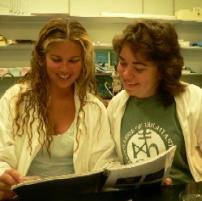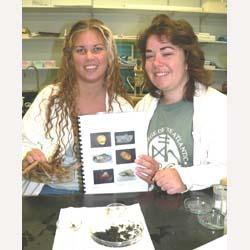Halfway around the world to work with flying fox poo and loving it
Published on 14 November, 2006
Wading through mud to collect flying fox guano may not be everyone’s idea of a good time, but American university students, Julie Byrd and Christiana Swanson have travelled halfway around the world to do just that.
Julie and Christiana are in Gladstone completing a 10-week internship at Central Queensland University’s Centre for Environmental Management and have been collecting flying fox guano as part of their research project.
 Working under the supervision of CEM research officer Ralph Alquezar, Julie and Christiana are looking at the effects of flying fox guano on intertidal macro benthic communities.
Working under the supervision of CEM research officer Ralph Alquezar, Julie and Christiana are looking at the effects of flying fox guano on intertidal macro benthic communities.
Mr Alquezar said the research students have spent the past 5 weeks collecting samples of the mud found underneath the resting areas of flying fox colonies in 3 local intertidal zones at Auckland Creek, the Boyne River and Wild Cattle Creek.
“Julie and Chirstiana will be looking at what effect, if any, the nutrients from the flying fox guano have on the macro benthic communities.
“The macro benthic organisms are the little critters that live in the mud and include small worms, crabs, mussels and clams. Although they’re at the bottom end of the food chain, they play a special and important contribution to the ecosystem.
“It’s important to know what’s happening with the macro benthic communities as what is happening to them has an effect all the way up the food chain,” said Mr Alqezar.
Julie Byrd, a graduate from the Florida Institute of Technology said she and Christiana had spent the past couple of weeks collecting samples from the 3 different areas.
“The areas chosen will help us to compare and contrast between an area that has no flying foxes and an area that has had flying foxes for a long time with an area where the bats have only recently arrived.
“We’ve been analysing the water in the areas and have now begun sorting the samples of mud and guano to determine what creatures we find where and how many of them we find,” said Ms Byrd.
 The students will then spend time analysing the data and reporting their findings to CEM staff.
The students will then spend time analysing the data and reporting their findings to CEM staff.
Christiana Swanson from the College of the Atlantic, Maine, said both she and Julie were thoroughly enjoying their time in Australia.
“It’s a great opportunity to come to another country and experience the different culture. It’s also important to see the way things are done differently in the research areas. We’re learning a lot in our time here and that will help us with our future studies and careers,” said Ms Swanson.
Both research students will return to America in December. Christina will return to Maine to complete her degree in Marine Science. Julie will return briefly to Florida before she returns to Australia to begin her post graduate studies in natural resource management with James Cook University.
Photos: American intern students, Julie Byrd (on left) and Christiana Swanson.

